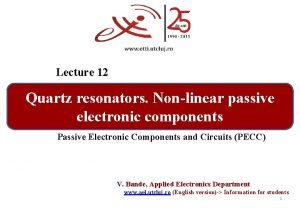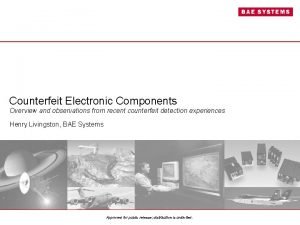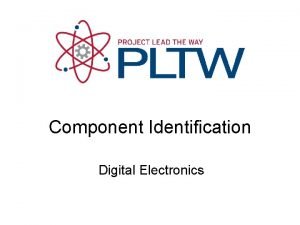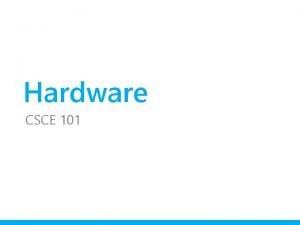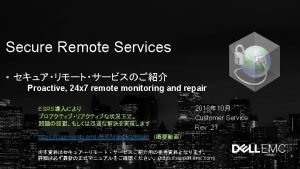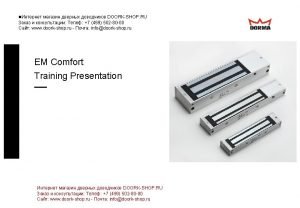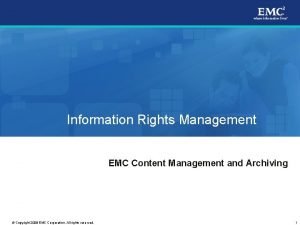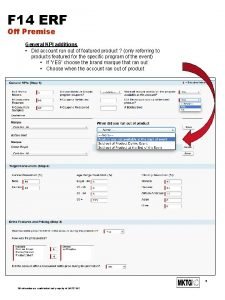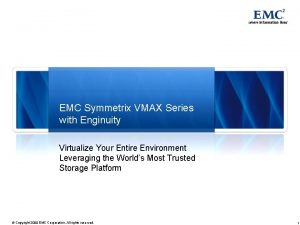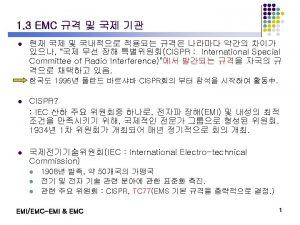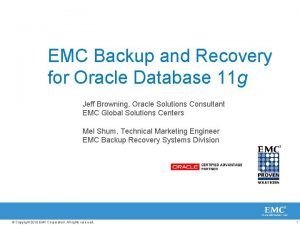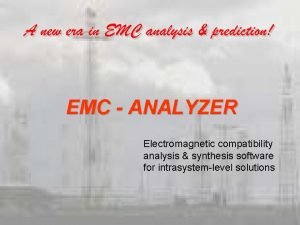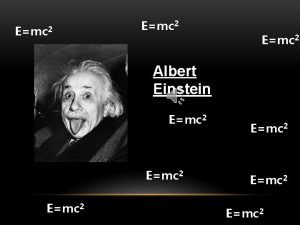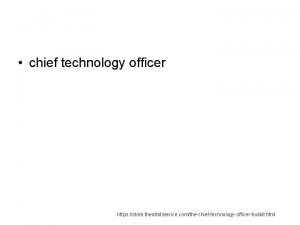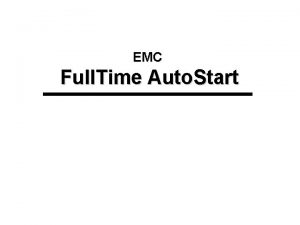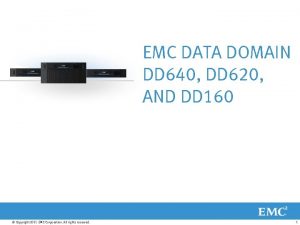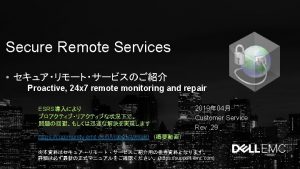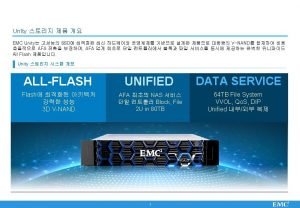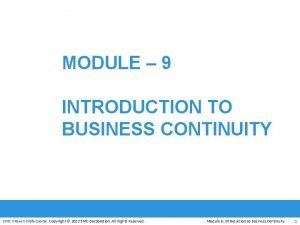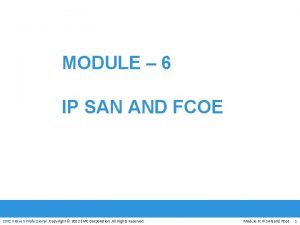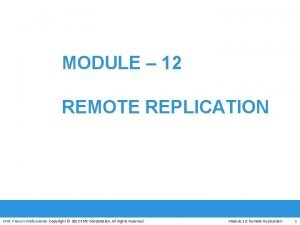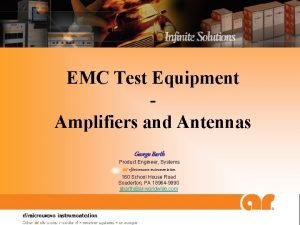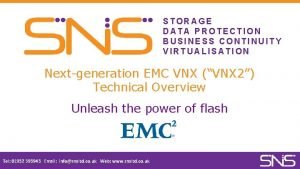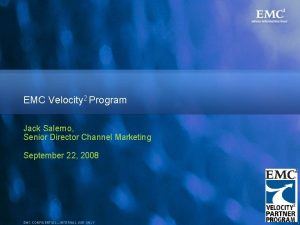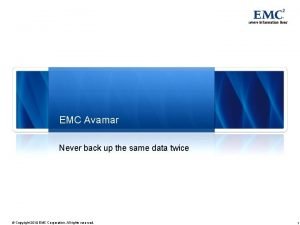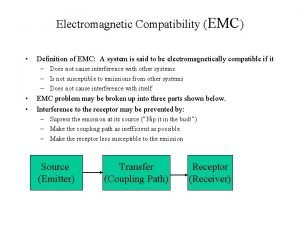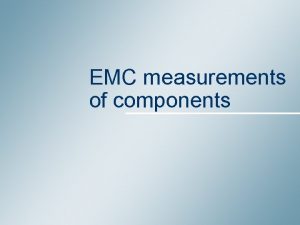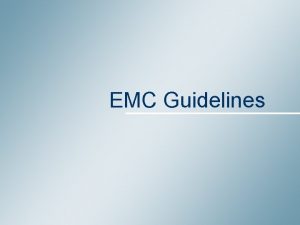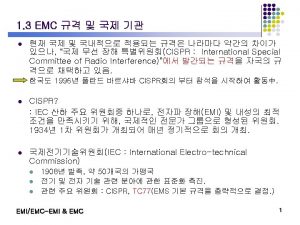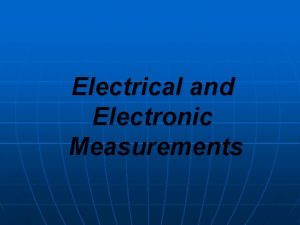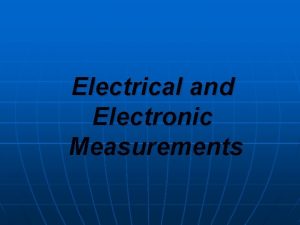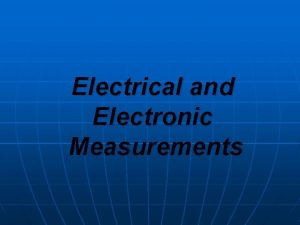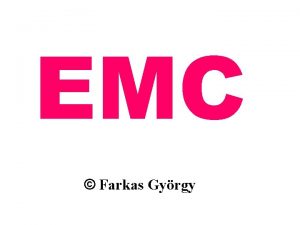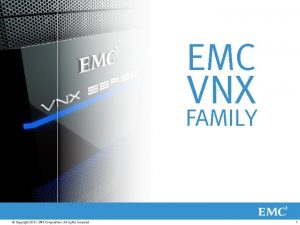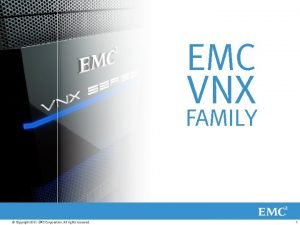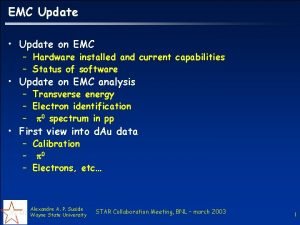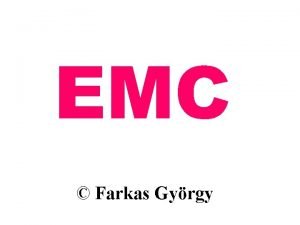EMC measurements of electronic components Summary 1 Context

























































- Slides: 57

EMC measurements of electronic components

Summary 1. Context - EMC certification 2. Illustration of electromagnetic emission produced by electronic devices 3. Illustration of susceptibility to electromagnetic disturbances of electronic devices 4. Some EMC measurement tests 5. Conclusion 2 September 21

Context - The EMC certification European Directives for electronic products ü RTT&E 1999/5/CE : for radio equipments and telecommunication terminals ü CEM 2004/108/CE : electromagnetic compatibility of electronic products ü BT 2006/95/CE : electric safety for electronic products (0 to 1000 volt AC and 1500 DC) ü Ro. HS 2011/65/UE : limitation of six hazardous substances (e. g. lead) ü DEEE 2002/96/CE : management of electric and electronic equipment waste 3 September 21

Context - The EMC certification EMC European Directive ü The European directive 89/336/EEC (1996) and then 2004/108/EC (2004) requires that all « electrical apparatus » placed on the European market : § Do not produce electromagnetic interferences able to disturb radio or telecom equipments , and the normal operation of all equipments § Have a sufficient immunity level to electromagnetic interferences to prevent any degradation of the normal operation. ü All manufacturers of « electrical apparatus » must certify that the directive is supposed respected by delivering a declaration of conformity and placing a CE mark on the product. CE mark ü Using harmonized standards adapted to the product to verify the supposition of conformity is recommended 4 September 21

Context - The EMC certification R&TTE European Directive ü The European directive 99/5/EC (1999) Radio & Telecommunications Terminal Equipment which is applied to all telecom and radio equipments emitting on the band 9 KHz – 3000 GHz replace the EMC directive. . ü R&TTE requires that telecom and radio equipments placed on the European market: : § Comply to safety constraints given by the Low Voltage directive (73/23/EEC) (e. g. the limit of EM exposure for persons) and the EMC constraints given by the EMC directive 2004/108/EC. § Radio equipments use spectral resources dedicated for terrestrial and spatial communications without generating any interferences. ü R&TTE mark: Required for all equipments under the R&TTE directive 5 September 21 Warning signal for class 2 equipments (special recommandations)

Context - The EMC certification Outside European Union ? • United States Federal Communications Commission (FCC) • Canada: Industrie Canada (IC) • Japan : Voluntary Control Council for Interference by Information Technology Equipment (VCCI) • China : China Compulsory Product Certification (CCC) • Australia – New-Zeland : Australian Communications Authority (ACA) • Taïwan : Bureau of Standards, Metrology and Inspection (BSMI) and National Communications Commission (NCC) • Russia : GOST (State Committee for Quality Control and Regulatory approchs of EMC in every countries. Standardization. . . Non harmonized regulation between countries, except if Mutual Recognition Agreements (MRA) exists. 6 September 21

Context - The EMC certification Role of EMC standards ü Define terms, units, general conditions ü Define measurement methods (equipments, configuration, set-up) ü Propose calibration procedures ü Give suggested/mandatory limits ü Guidelines for test reports ü Appropriate for all products ? For all environments ? For all operating configurations ? ü Do standards change with time ? 7 September 21

Context - The EMC certification EMC normative bodies International European International Electrotechnical Commission(IEC) TC 77 IEC 61000 -X European Commitee for Electrotechnical Standardization European Telecommunication Standards Institute (CENELEC) (ETSI) Comité International Spécial des Perturbations Radioélectriques(CISPR) Harmonized standards EN 50 XXX EN 55 XXX EN 6 XXXX CISPR-XX 8 September 21 EN 300 XX

Context - The EMC certification Commercial harmonized standard (non exhaustive list !) Basic standard (general and fundamental rules) Generic standard (for equipments in a specific environment) Product standard (for a specific product family) EN 61000 -4 -x (IEC 61000 -4 -x) EMC – Testing and measurement techniques EN 61000 -6 -3 (IEC 61000 -6 -3) Generic Emission Standard, for residential, commercial and light industrial environment EN 61000 -6 -1 (IEC 61000 -6 -1) Generic Immunity Standard, for residential, commercial and industrial environment EN 55022 (CISPR 22) Information technology equipment (ITE) EN 55014 (CISPR 14) Household appliances, electric tools and similar apparatus EN 55012 (CISPR 12) Vehicles, boats and internal combustion engines EN 330220 (ETSI 330 220) EN 330330 (ETSI 300330 -1) Electromagnetic compatibility and radio spectrum matters (ERM); Short Range Devices (SRD); Radio equipment to be used in the 25 MHz to 1 000 MHz frequency range with power levels ranging up to 500 m. W; Electromagnetic compatibility and radio spectrum matters (ERM); Short Range devices (SRD); Radio equipment to be used in the frequency range 9 KHz to 25 MHz and inductive loop systems in the frequency range 9 KHz to 30 MHz 9 September 21

Context - The EMC certification Commercial harmonized standard (non exhaustive list !) ü Automotive, military, aerospace and railway industries have developed their own EMC standards. Applications Standard references Automotive ISO 7637, ISO 11452, CISPR 25, SAE J 1113 Aerospace DO-160, ED-14 Military MIL-STD-461 D, MIL-STD-462 D, MILSTD-461 E Railway EN 50121 10 September 21

Context - The EMC certification Case study 1 n Are the following product subject to the EMC European directive ? üWi. Fi dongle (ISM band) üServer motherboard üPassive antenna passive for RFID application üWireless audio headset 11 September 21

Context - The EMC certification Case study 2 n You want to place on the European market a notebook. n Are you under the European EMC directive 2004/108/EC ? n If yes, which EMC standard(s) should you follow ? What tests should you conduct for the EMC certification ? 12 September 21

Context - The EMC certification Case study 2 n Application of EN 55022 : “Information technology equipment – Radio disturbance characteristics – Limits and methods of measurement” and EN 55024 : « Information technology equipment – Immunity characteristics – Limits and methods of measurement » : § Any equipment dedicated to processing, storage, display, control of data and telecommunication messages, equipped with one or more ports, and supplied under less than 600 V. § Except equipments or modules dedicated only to radio emission or reception. 13 September 21

Context - The EMC certification Case study 2 n Suggested emission tests: Conducted emission 150 KHz – 30 MHz on power supply mains 150 KHz – 30 MHz on telecommunication ports Radiated emission n 30 MHz – 6 GHz @ 3 or 10 m Suggested immunity tests: ESD EFT / burst Conducted immunity Radiated immunity Surge Voltage dips and interruptions +/- 4 KV contact, +/- 8 KV air 5/50 ns, 1 KV, 5 KHz repetition 150 KHz – 80 MHz, 3 V rms 80 – 1000 MHz, 3 V/m, modulation AM 1 KHz 80% 1 KV 1. 2/50 µs pulse on power 40 % variations of the power supply, repeated 5× 14 September 21

Context - The EMC certification Case study 3 n You are a semiconductor manufacturers and you want to sell your integrated circuits in the European market. Your ICs are dedicated to automotive applications. n Which EMC standard(s) should you follow ? What tests should you conduct for the EMC certification ? 15 September 21

Context - The EMC certification Case study 3 n If your integrated circuits can not operate by themselves, you don’t need EMC certification. n However, your customers will certainly push you to guarantee the low emission and susceptibility of your devices, require measurements, models, support…. n Examples of standards providing EMC measurement for ICs: • IEC 61967: Integrated Circuits, Measurement of Electromagnetic Emissions, 150 k. Hz to 1 GHz • IEC 62132: Integrated circuits - Measurement of electromagnetic immunity, 150 k. Hz to 1 GHz • ISO 11452: Road vehicles - Electrical disturbances by narrowband electromagnetic energy - Component test methods • ISO 7637 or IEC 61000 -4 -2/4/5 for ESD, pulse, surge testing. 16 September 21

EMC measurements of components Illustration of electromagnetic emission produced by electronic devices 17 September 21

Electromagnetic emission of electronic devices Emblematic EMC equipment – Spectrum Analyser (EMI receiver) Frequency adjustment : Start, stop , center Y= power (d. Bm, d. BµV) RBW – frequency resolution, noise floor reduction 50 Ohm input X= frequency n. Emission VBW – smooth display measurement requires high sensitivity and resolution n. Emission measurement standards often recommend spectrum analyser adjustment 18 September 21 Amplitude adjustment : Level reference, dynamic.

Electromagnetic emission of electronic devices Emblematic EMC equipment – Spectrum Analyser (EMI receiver) n Principle: based on super heterodyne receiver IN Input signal Mixe r OUT f Frf Local LO oscillator Flo Output signal IF filter Fif Frf+Fl f o f OUT IF A filter RBW No Fif ωif Detected power: f 19 P= ½. A²+No. RBW September 21

Electromagnetic emission of electronic devices Emblematic EMC equipment – Spectrum Analyser (EMI receiver) n Building blocks and adjustable elements: Input Attenuatio n signal Attenuator DC blocking Mixers Low pass filter Gain IF RB IF filter W Analog filter Local oscillator Frequency sweep Fstart / Fstop Fcenter / Span Point number Display Reference oscillator 20 Gain log Detecto Envelope r VB detector Video W filter September 21

Electromagnetic emission of electronic devices Emblematic EMC equipment – Spectrum Analyser (EMI receiver) n What are the main adjustments ? n What are their effects on measurement result ? 21

Electromagnetic emission of electronic devices Emblematic EMC equipment – Spectrum Analyser (EMI receiver) n. Example: effect of RBW and VBW. n. Measurement of 100 MHz sinus. Amplitude = 90 d. BµV Sweep time : RBW = 100 KHz 2. 5 ms RBW = 10 KHz 100 ms Amplitude = 20 d. BµV 22 Sweep time : VBW = 30 KHz 100 ms VBW = 1 KHz 980 ms September 21

Electromagnetic emission of electronic devices Emblematic EMC equipment – Spectrum Analyser (EMI receiver) n. Example: Influence of detector type (peak vs. quasi-peak vs. average). n. Measurement of radiated emission of a microcontroller. 23 September 21

Electromagnetic emission of electronic devices Case study 4 – Electromagnetic emission from a class-D amplifier n MAX 9768 – 10 W mono class D speaker amplifier, EN 55022 class B compliant. n Applications: low power portable application (notebook computer, Multimedia monitor, GPS navigation system…) 24 September 21 www. maxim. co m

Electromagnetic emission of electronic devices Case study 4 – Electromagnetic emission from a class-D amplifier n Class D amplifier principle (half-bridge): VDD Triangle waveform oscillator + PWM signal Output filter - Amplified audio signal Speake r Audio source GN D 25 September 21

Electromagnetic emission of electronic devices Case study 4 – Electromagnetic emission from a class-D amplifier n Measure and compare the currents circulating on wires OUT+ and OUT- of the speaker cable. n Are they perfectly symmetrical ? GN D I+ Class D GN D I- GN D 26 September 21 8Ω Speaker

Electromagnetic emission of electronic devices Case study 4 – Electromagnetic emission from a class-D amplifier n Differential vs. common mode currents. n Common mode appears when the return current path is not perfectly defined. If I 1 ≠ I 2 Interco 1 I 2 Interco 2 Differential mode Decomposition in 2 distinct propagation modes Common mode Id Id 1 2 Ic 1 2 27 September 21 Ic

Electromagnetic emission of electronic devices Case study 4 – Electromagnetic emission from a class-D amplifier n Differential vs. common mode radiation (at a distance r in far-field). I 1 d I 2 L << λ L=1 m, d=2 mm, r = 3 m, IDM = 20 m. A, ICM = 200 µA Evaluate radiation produced by the cable output of the class-D amplifier. 28 September 21

Electromagnetic emission of electronic devices Case study 4 – Electromagnetic emission from a class-D amplifier n Evaluate the differential and common-mode radiation at 3 m produced by the speaker cable. n Does it comply with EN 55022 class B standard ? 29 September 21

Electromagnetic emission of electronic devices Case study 5 – Electromagnetic emission from a microcontroller Transient current produced by IC activity leads to conducted and radiated emission. Vdd Dig IMem(t) Icore(t) Digital Core Vdd osc Memory Vdd IO Integrated circuit Iosc(t) Oscillator PLL n Analog I/O IIO(t) IA(t) Vdd A 30 September 21 PCB lines Ext. Loads

Electromagnetic emission of electronic devices Case study 5 – Electromagnetic emission from a microcontroller n Magnetic field around a wire: Tangential probe Vmea s H Hy Scan axis Vertical probe z y I y Vmea s Hz x n Link between the magnetic field and probe voltage: September 21 y

Electromagnetic emission of electronic devices Case study 5 – Electromagnetic emission from a microcontroller n The microcontroller Freescale MPC 5604 B has the following configuration: n CPU running at 40 MHz n Internal clock produced by an on-chip PLL running at 80 MHz, synchronized by a 8 MHz quartz oscillator n 13 I/O switching at 200 k. Hz n With a near-field probe, locate the main source of electromagnetic emission created by the microcontroller. n Do they really contribute to far-field radiated emission? 32 September 21

Electromagnetic emission of electronic devices Case study 5 – Electromagnetic emission from a microcontroller n Pin-out of microcontroller Freescale MPC 5604 B: VDDHV/VSSH V (I/O supply) VDDHV_ADC/VSSHV_ ADC (ADC supply) 5 I/O switching at 200 k. Hz VDDLV/VSSLV (Core + PLL supply) 8 I/O switching at 200 k. Hz Externa l quartz 33 September 21

Electromagnetic emission of electronic devices Case study 5 – Electromagnetic emission from a microcontroller n Near-field vs. far-field emission 34 September 21

Electromagnetic emission of electronic devices Case study 6 – Radiated emission from a digital line n Simple radiated emission model for a PCB microstrip line: Magnetic-field emission in near-field Worst-case electromagnetic emission in farfield: 35 September 21

Electromagnetic emission of electronic devices Case study 6 – Radiated emission from a digital line n Consider the following PCB digital line between two CMOS inverters: Magnetic-field probe (Loop radius = 2 mm) Inverter AHCT 04 10 MHz Inverter AHCT 04 Microstrip line (w = 1 mm, h = 1. 6 mm, L = 10 cm) n At three different frequency between 10 and 1000 MHz, estimate the current which circulated along the microstrip line. n Estimate the far-field emission at 3 meter. n Does the radiated emission comply with EN 55022 limit? 36 September 21

EMC measurements of components Illustration of susceptibility to electromagnetic disturbances (RFI) of electronic devices 37 September 21

Susceptibility of electronic devices to RFI Effect of IC malfunction due to EM disturbance n Striking of berth by Coastal Inspiration, 20 th dec 2011, Nanaimo, British Columbia, Canada. n A problem of an amplifier, due to EM disturbances, leads to a failure in speed reduction command. 38 September 21

Susceptibility of electronic devices to RFI Case study 7 – Susceptibility of a bandgap reference voltage n LTC 1798: 2. 5 V micropower bandgap voltage reference RFI 2. 7 V to 12 V LTC 1798 Effect on the output voltage ? 2. 5 V +/- 4 100 n. F m. V n Couple an harmonic conducted disturbance to the input of the bandgap reference. n Observe the effect on the output voltage, for frequencies ranging from 1 to 100 MHz. 39 September 21

EMC measurements of components Some EMC measurement tests 40 September 21

Emission measurement set-up Emission – General measurement set-up Control Acquisition Radiated or conducted coupling Acquisition system 50Ω adapted cable Coupling device ü Coupling network ü Antennas Device under test ü Waveguide Result de-embedding Post-processing 41 September 21 ü Spectrum analyser ü EMI receiver

Emission measurement set-up Typical conducted emission test for electronic/electrical products n Frequency range = 150 k. Hz – 30/150 MHz Line Impedance Stabilized Network(LISN) Current clamp Power supply harness EUT Load harness Load Ground plane 42 September 21 EMI receiver

Emission measurement set-up Typical conducted emission test for electronic/electrical products n Conducted emission test with Line Impedance Stabilizer Network (LISN) 43

Emission measurement set-up Typical radiated emission test for electronic/electrical products n Frequency range = 30 MHz/80 MHz – 1 GHz and more EN 55022 (Siepel) Absorbents 1 m Wide band (calibrated) antenna EMI receiver or spectrum analyzer) Device under test 1 m ALSE = Faraday cage (with absorbents: semianechoic chamber) R = 3 ou 10 m 1 m 44 Power supply, DUT control

Emission measurement set-up Typical radiated emission test for electronic/electrical products If far field and free space conditions ensured: Optional pre-amplifier Low loss 50 Ω cable Vemi E field EMI receiver Rs =50 Ω Bilog antenna (or log-periodic, biconical, dipole…) Voltage Vemi or Power Pemi AF = Antenna factor (from calibration) The E field varies in 1/r with the distance r (the radiated power in 1/r²) possible extrapolation of field intensity. 45 September 21

Emission measurement set-up IC Conducted emission - IEC 61967 -4 – 1 ohm / 150 ohms method n Conducted emission is produced by RF current induced by IC activity. n The current induced voltage bounces along power distribution network and radiated emission. The « 1 ohm » method aims at measuring the RF current flowing from circuit Vss pin(s) to the ground reference. 46 September 21

Emission measurement set-up IC Conducted emission - IEC 61967 -4 – 1 ohm / 150 ohms method n ds. PIC 33 F: measurement in time domain and frequency of the voltage across the 1 Ω probe proportional to the IC current. 47 September 21

Emission measurement set-up IC Conducted emission - IEC 61967 -4 – 1 ohm / 150 ohms method n I/O switching is a major contributor to conducted emission. n They induced voltage fluctuation along power supply and I/O lines. The « 150 ohms » method aims at measuring the RF voltage induced at one or several IC output. 48 September 21

Susceptibility measurement set-up Susceptibility measurements – General measurement set-up Injected level Extraction Disturbance generation 50Ω adapted cable Radiated or conducted coupling ü Harmonic signal Coupling device ü Coupling network ü Transients ü Antennas ü Burst ü Waveguide Result de-embedding Port-processing 49 September 21 Device under test

Susceptibility measurement set-up Susceptibility measurements – General measurement set-up n Typical signals for susceptibility tests: 50 September 21

Susceptibility measurement set-up Susceptibility measurements –Test procedure for harmonic disturbance Start F = Fmin P = Pmin Increase P Increase F Without RFI Wait dwell time Detection mask Failure or P = Pmax ? F = Fmax ? Save F and P With RFI End 51 September 21 Failure

Susceptibility measurement set-up Typical radiated susceptibility test for electronic/electrical products n Frequency range = 30 MHz/80 MHz – 1 GHz and more Typical max. RI level: Commercial product: 3 – 10 V/m Automotive (ISO-11452 -2): 25 – 200 V/m Military (MIL-STD 461 E): 20 – 200 V/m Aeronautics (DO 160 -D): 8 – 800 V/m (Siepel) Field monitoring Absorbents Signal synthesizer 1 m Power amplifier ( > 100 W) Wide band (calibrated) antenna Device under test 1 m R = 3 ou 10 m 1 m 52 ALSE (with absorbents: semi-anechoic chamber) Power supply, DUT control September 21

Susceptibility measurement set-up Typical conducted susceptibility test for electronic/electrical products n Bulk Current Injection: 150 k. Hz – 400 MHz Signal synthesizer Power amplifier RF disturbance Directional coupler Loa d. LIS N Bus, cable Injection clamp Induced RF current Induced current measurement Failure ? DUT Interface Microcontroler Measureme circuit nt clamp Faraday cage è Usually, the max. current is between 50 m. A and 300 m. A. 53 September 21

Conclusion Does EMC certification cancel the interference risks? Example: radiated emission limits defined by different EMC standards 54 September 21

Conclusion Does EMC certification cancel the interference risks? A radio receiver operating at 868 MHz has a receiving sensitivity of 90 d. Bm. Its radio input is 50 Ω-matched and is terminated by an antenna with an antenna factor of 10 d. B/m. The radio receiver is placed 2 metres from some noisy electronic equipment with a CE marking, compliant with standard EN 55022 – class B (refer to Figure 7 - 8 for the radiated emission limit defined by EN 55022). The radiated emission test for the noisy equipment is performed in an ALSE. A receiving antenna with a gain of 23 d. B/m is placed 3 metres in front of the noisy equipment. The antenna is connected to an EMI receiver by cables and a 30 d. B preamplifier. The total cable loss is equal to 2 d. B. The maximum level measured by the EMI receiver at 868 MHz is 40 d. BµV. 55 September 21

Conclusion Does EMC certification cancel the interference risks? 1. What is the maximum electric field radiated by the noisy electronic equipment at a distance of 1 metre? 2. According to the details given about the noisy equipment’s radiated emission test, compute the electric field at 868 MHz at a distance of 3 metres. Does the equipment comply with the limit defined by EN 55022? 3. Compute the electric field produced by the noisy equipment illuminating the radio receiver at 868 MHz. 4. Compute the voltage and power induced at the radio receiver input. 5. Draw a conclusion about the interference between the noisy equipment and the radio receiver. Do you think that compliance with EN 55022 is a guarantee against interference? 56 September 21

Conclusion Evaluation of emission/susceptibility problems of circuits Circuit Emission issues Susceptibility issues Justification Driver chip for a TFT LCD monitor LDO linear voltage regulator Boost converter IEEE 802. 15. 4 Zigbee transceiver chip FPGA supporting numerous high speed interfaces LIN bus driver for automotive application 57 September 21
 Is the electronic exchange of money or scrip
Is the electronic exchange of money or scrip Electronic field production examples
Electronic field production examples High context vs low context culture ppt
High context vs low context culture ppt Communicating across generational differences
Communicating across generational differences Constancy under negation examples
Constancy under negation examples Soal essay komunikasi verbal
Soal essay komunikasi verbal Nonlinear electronic components
Nonlinear electronic components Counterfeit electronic components an overview
Counterfeit electronic components an overview Electrical component identification
Electrical component identification Contains the central electronic components of the computer
Contains the central electronic components of the computer Electronic payments definition
Electronic payments definition Emc of teamhealth
Emc of teamhealth Esrs port
Esrs port Emc 1200 alh
Emc 1200 alh Emc irm
Emc irm Hvad er emc
Hvad er emc Types of storage area networks
Types of storage area networks Mktg emc
Mktg emc Emc symmetrix vmax
Emc symmetrix vmax Emc smarts global console
Emc smarts global console En 61000-6-3
En 61000-6-3 Quatro rail tech solutions ltd
Quatro rail tech solutions ltd Emi emc 차이
Emi emc 차이 Emc disaster recovery
Emc disaster recovery Emc backup and recovery
Emc backup and recovery Emc analysis software
Emc analysis software Site:slidetodoc.com
Site:slidetodoc.com Emc einstein
Emc einstein Dell storage nas
Dell storage nas Dell partner incentives
Dell partner incentives Dell 서버 라인업
Dell 서버 라인업 Aerion emc
Aerion emc Emc la politesse
Emc la politesse Opensim oar files
Opensim oar files Emc publishing llc
Emc publishing llc Emc autostart
Emc autostart Data domain 160
Data domain 160 Emc avamar
Emc avamar Dell business account
Dell business account Which phase is the operationalize in big data analytics
Which phase is the operationalize in big data analytics Dell secure connect gateway
Dell secure connect gateway Pechhulp emc
Pechhulp emc Emc information storage and management
Emc information storage and management Trusted content services
Trusted content services Vivre ensemble cycle 1
Vivre ensemble cycle 1 Emc storage integrator
Emc storage integrator Coherence and unity
Coherence and unity Omentectomie
Omentectomie Module 12 - introduction to business continuity
Module 12 - introduction to business continuity Emc fco
Emc fco Emc proven professional
Emc proven professional Twt amplifiers for emc testing
Twt amplifiers for emc testing Emc en seconde
Emc en seconde Mcfdevicecontinuity
Mcfdevicecontinuity Prodeploy enterprise suite sales overview
Prodeploy enterprise suite sales overview Emc velocity
Emc velocity Avamar ndmp accelerator
Avamar ndmp accelerator Electromagnetic compatibility definition
Electromagnetic compatibility definition






